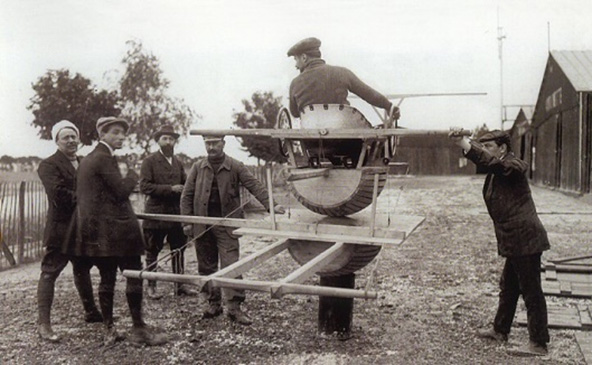
Pictured: The Antoinette Barrel. Photo courtesy of the IEEE History Center.
Early aviation was incredibly dangerous, with crashes being commonplace. The first aircraft lacked many of today’s safety protocols and often had controls that were not standardized. While the first powered flight was in 1903, flight simulators started to appear around 1910, and the French aviation manufacturer Antoinette developed one of the earliest working simulators for instructional purposes.
In May of 1906, Léon Levavasseur and Jules Gastambide founded La Société Antoinette as a way to produce their V8 and V16 engines. After Alberto Santos-Dumont’s flight to Bagatelle in late 1906 using the Antoinette 50hp V8 engine, French aviators adopted the company’s engines, and Antoinette produced fifty engines between the summer of 1906 and 1907. Following their success producing engines, Antoinette began producing aircraft. Initially funded by Gastambide, and with the design work of engineer Gabriel Mangin, the company’s Antoinette II monoplane flew for the first time on 8 February 1908. In 1909, the company received international attention when Hubert Latham flew an Antoinette IV monoplane for 67 minutes, at that time a record in France. The next day he won the Prix Ambroise Goupy, a 1,000 Franc prize awarded for flying in a straight line for more than five kilometers, where Latham flew six kilometers in four minutes, thirteen seconds. In the following years, with the Antoinette models IV, VI and VII, Latham continued to set various records for longevity and altitude.

While Latham was able to set several records with Antoinette aircraft, they were difficult to fly. Rather than using a flight stick, the Antoinette planes used two wheels on opposite sides of the cockpit attached to a rudder bar and operated by hand, the left operating the ailerons, and the right for elevation. Many pilots found this control layout to be completely non-intuitive and had difficulty piloting the plane. In 1910, the Antoinette company’s workshop at Mourmelon near the military camp Camp de Châlons, was commissioned by the French military to design a two-seater monoplane, and at the behest of commanders Georges Clolus, Alexandre Laffont and Lieutenant Pierre Clavenad, the company also created a simulator as an instruction tool for learning the complicated controls of the airplane. The result of this was the Antoinette Barrel, an aptly named simulator made out of a barrel cut in half, which was designed to minimize flight difficulty and to extensively familiarize the pilot with controls before taking off. The short wings attached to the barrel were placed around shoulder height so that instructors could manually move the wings or reposition the barrel, simulating turbulence. Emulating the controls of the aircraft, the wheels would manipulate the pitch and roll of the barrel, with the pilot’s goal to balance out the external forces exerted by the instructor, and aligning a bar with the horizon.

Despite their innovative use of simulation, and already possessing two Antoinette monoplanes, the French Army ultimately looked to Robert Esnault-Pelterie to commission their aircraft. Without a stable buyer, Antoinette was not able to sustain itself and ultimately went bankrupt in 1912. While short-lived, the Antoinette’s model of flight simulation was adopted in parallel by other airplane manufacturers. In 1910, the Wright brothers developed their “kiwi bird” simulator, a repurposed mounted Wright Type B flyer. Demand for flight trainers increased with the onset of World War I, and further expanded during World War II with the Link Trainer simulator selling more than 10,000 units during war, training more than 500,000 U.S. pilots. Simulators were essential to the success of the space program, and today are commonplace for the training of new commercial and military pilots. For non-pilots, they have inspired a successful genre of video games. The Antoinette Barrel, while a short-lived curiosity, was an early demonstration that with the increasing demand of powered flight, it was equally important to focus on human safety in addition to technical design.
References
Aerotoons Blog, “Flight Simulators of Yesteryear,” https://www.aerotoons.com/blog/yesteryear_sims.html
Baldetti, Giuseppe; Ghezzi, Giorgio; Ghiringhelli, Cristiano; Nacamulli, Raoul Claudio. Simulando s’impara. Progettare e gestire ambienti complessi di apprendimento. Il caso Enav Academy: Progettare e gestire ambienti complessi di apprendimento. Il caso Enav Academy. (Milan: FrancoAngeli, 2015) https://books.google.com/books?id=LpmyBwAAQBAJ
The Dreamy Dodo, Aviation Rapture. “Tonneau d’Antoinette: Mental Games,” 2013. https://elpoderdelasgalaxias.wordpress.com/2013/10/06/tonneau-dantoinette-mental-games/
Hancock, Peter; Vincenzi, Dennis A.; Wise, John A.; Mouloua, Mustapha, Human Factors in Simulation and Training. (Boca Raton: CRC Press, 2008). https://books.google.com/books?id=cgT56UW6aPUC
Hartmann, Gérard, “Les moteurs et aéroplanes Antoinette,” 2006. https://www.hydroretro.net/etudegh/les_moteurs_et_aeroplanese_antoinette.pdf
Léoutre, Pierre. Histoire de Fleurance. (Books on Demand, 2019). https://books.google.com/books?id=Q8qbDwAAQBAJ
Meyniel, Stéphanie. “Le 6 juin 1909 dans le ciel : Hubert Latham gagne le prix Ambroise Goupy.” Air Journal, 6 June 2012. https://www.air-journal.fr/2012-06-06-le-6-juin-1909-dans-le-ciel-hubert-latham-gagne-le-prix-ambroise-goupy-549040.html
Owen, Harry. “Early Flight Simulators.” A History of Simulation, 2017. https://www.historyofsimulation.com/early-flight-simulators-2/
Ward, Ed. “How virtual reality is paving the way for future pilots,” Hush-Kit, 2 September 2019. https://hushkit.net/2019/09/02/how-virtual-reality-is-paving-the-way-for-future-pilots/
Nathan Brewer is archival and digital content specialist at the IEEE History Center at the Stevens Institute of Technology in Hoboken, N.J. Visit the IEEE History Center’s Web page at: https://www.ieee.org/about/history_center/index.html






